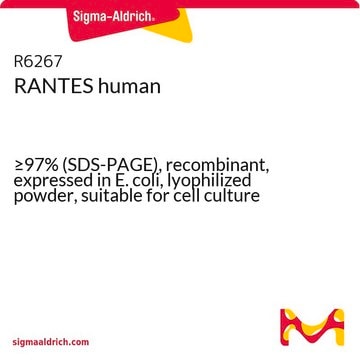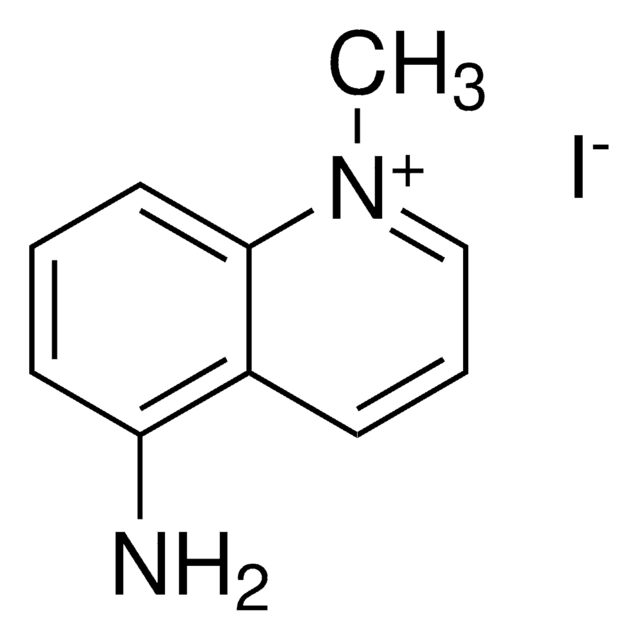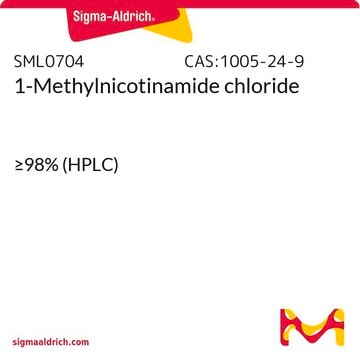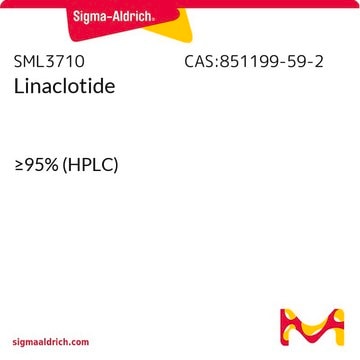SRP3269
RANTES human
Animal-component free, recombinant, expressed in E. coli, ≥98% (SDS-PAGE), ≥98% (HPLC)
Sinonimo/i:
CCL5, SIS-delta
Autenticatiper visualizzare i prezzi riservati alla tua organizzazione & contrattuali
About This Item
Codice UNSPSC:
12352200
NACRES:
NA.32
Prodotti consigliati
Origine biologica
human
Ricombinante
expressed in E. coli
Saggio
≥98% (HPLC)
≥98% (SDS-PAGE)
Stato
lyophilized
Potenza
1.0-10.0 ng/mL
PM
7.8 kDa
Confezionamento
pkg of 20 μg
Impurezze
<0.1 EU/μg endotoxin, tested
Colore
white
N° accesso UniProt
Condizioni di spedizione
wet ice
Temperatura di conservazione
−20°C
Informazioni sul gene
human ... CCL5(6352)
Descrizione generale
Regulated on activation, normal T cell expressed and secreted (RANTES) also known as C-C motif chemokine ligand 5 (CCL5) is encoded by the gene mapped to human chromosome 17. RANTES belongs to intercrine or chemokine family of proinflammatory basic polypeptides and is expressed by various hematopoietic and non-hematopoietic cell types involved in homing and migration of effector and memory T cells during acute infections. Recombinant human RANTES is a 7.8kDa protein containing 68 amino acid residues including the four highly conserved cysteine residues present in the CC chemokines.
Applicazioni
RANTES human has been used in following studies:
- In transmigration experiments to determine whether LFA-1 cross-linking could affect peripheral blood T lymphocytes (PBTL) migration in response to the chemokine RANTES.
- Luminol-dependent chemiluminescence assay to determine the effect of RANTES on reactive oxygen species (ROS) production by eosinophils.
Azioni biochim/fisiol
Regulated on activation, normal T cell expressed and secreted (RANTES) is a chemoattractant towards monocytes, dendritic cells (DCs), memory T cells (CD4+/CD45RO), basophils, and eosinophils. The encoded chemokine protein functions as a ligand for CCR1, CCR3, and CCR5.1 RANTES inhibits the action of R5 strains of HIV-1 via blocking CCR5 receptor. The In1.1C variant of RANTES gene is linked with susceptibility to HIV-1 infection and disease progression. Hence, this can be used as a potent biomarker to determine the prognosis of HIV-1 infection.
Stato fisico
Lyophilized with no additives.
Ricostituzione
Centrifuge the vial prior to opening. Reconstitute in water to a concentration of 0.1-1.0 mg/mL. Do not vortex. This solution can be stored at 2-8°C for up to 1 week. For extended storage, it is recommended to further dilute in a buffer containing a carrier protein (example 0.1% BSA) and store in working aliquots at -20°C to -80°C.
Codice della classe di stoccaggio
10 - Combustible liquids
Classe di pericolosità dell'acqua (WGK)
WGK 3
Punto d’infiammabilità (°F)
Not applicable
Punto d’infiammabilità (°C)
Not applicable
Scegli una delle versioni più recenti:
Certificati d'analisi (COA)
Lot/Batch Number
Non trovi la versione di tuo interesse?
Se hai bisogno di una versione specifica, puoi cercare il certificato tramite il numero di lotto.
Possiedi già questo prodotto?
I documenti relativi ai prodotti acquistati recentemente sono disponibili nell’Archivio dei documenti.
Role of chemokine and cytokine polymorphisms in the progression of HIV-1 disease.
Mahajan SD
Biochemical and Biophysical Research Communications, 396(2), 348-352 (2010)
Upregulated response to chemokines in oxidative metabolism of eosinophils in asthma and allergic rhinitis.
Sannohe S
The European Respiratory Journal, 21(6), 925-931 (2003)
J J Oppenheim et al.
Annual review of immunology, 9, 617-648 (1991-01-01)
A family consisting of at least ten distinct novel 8-10 kd cytokines has been identified over the past 12 years. These cytokines exhibit from 20 to 45% homology in amino acid sequence, are probably all basic heparin-binding polypeptides, and have
RANTES-activated human T lymphocytes. A role for phosphoinositide 3-kinase.
Turner L
Journal of Immunology, 155(5), 2437-2444 (1995)
Inside the crawling T cell: leukocyte function-associated antigen-1 cross-linking is associated with microtubule-directed translocation of protein kinase C isoenzymes beta(I) and delta.
Volkov Y
Journal of Immunology, 161(12), 6487-6495 (1998)
Il team dei nostri ricercatori vanta grande esperienza in tutte le aree della ricerca quali Life Science, scienza dei materiali, sintesi chimica, cromatografia, discipline analitiche, ecc..
Contatta l'Assistenza Tecnica.








